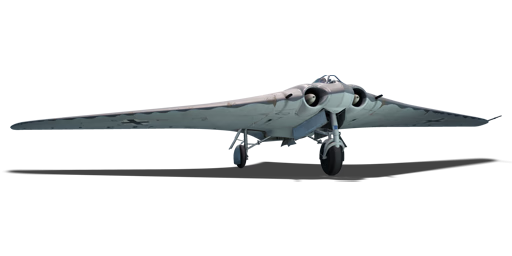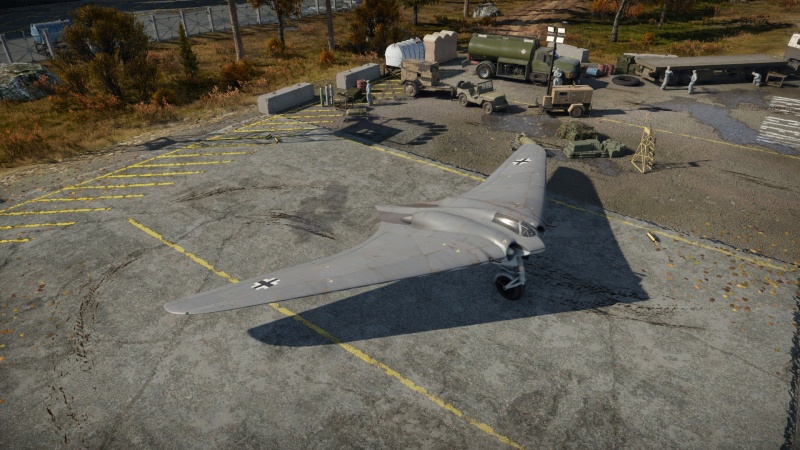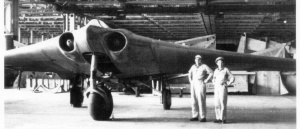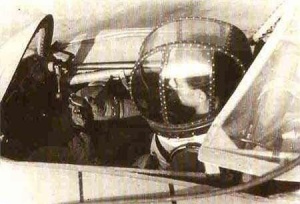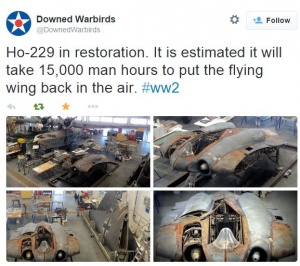Difference between revisions of "Ho 229 V3"
m (→External links) |
m (→Details) |
||
| Line 57: | Line 57: | ||
! Combat !! Take-off !! Landing !! + !! - | ! Combat !! Take-off !! Landing !! + !! - | ||
|- | |- | ||
| − | | {{Specs|destruction|body}} || {{Specs|destruction|gear}} || | + | | {{Specs|destruction|body}} || {{Specs|destruction|gear}} || 558 || 529 || 380 || ~10 || ~5 |
|- | |- | ||
|} | |} | ||
Revision as of 18:03, 17 February 2021
Contents
Description
The Ho 229 V3 is a rank V German jet fighter with a battle rating of 6.7 (AB), 7.0 (RB), and 7.7 (SB). It was introduced in Update 1.43.
The Ho 229 V3 is the first jet in the "Zerstörer" tech tree of the Luftwaffe and currently comes before the G.91 R/3. Ironically, it goes against much of the doctrine set by the previous planes, favouring speed and manoeuvrability over armament and durability.
Something that will immediately stand out with the Ho 229 V3 is how incredibly manoeuvrable it is compared to most other jet fighters. The Ho 229 V3 can almost quite literally turn on a dime and can even in some circumstances out-turn late super props such as the P-51H if manoeuvred correctly. However, if its manoeuvrability is used to its full extent, it also causes the plane to bleed speed at a crippling rate, making a sustained turn fight impossible to win. As such, it is advised to use the Ho 229 V3 as a Boom & Zoom fighter in order to maintain airspeed and altitude. Remember that jet engines' efficiency is directly proportional to the IAS, due to the increased air intake, meaning the Ho 229 V3 will be accelerating very slowly between 0-500 km/h, but beyond will be able to outrun any propeller-driven aircraft.
General info
Flight performance
| Characteristics | Max Speed (km/h at 8,000 m) |
Max altitude (metres) |
Turn time (seconds) |
Rate of climb (metres/second) |
Take-off run (metres) | |||
|---|---|---|---|---|---|---|---|---|
| AB | RB | AB | RB | AB | RB | |||
| Stock | 871 | 847 | 12000 | 24.8 | 25.4 | 17.0 | 16.1 | 850 |
| Upgraded | 947 | 910 | 23.7 | 24.0 | 25.3 | 21.0 | ||
Details
| Features | |||||
|---|---|---|---|---|---|
| Combat flaps | Take-off flaps | Landing flaps | Air brakes | Arrestor gear | Drogue chute |
| ✓ | ✓ | ✓ | ✓ | X | X |
| Limits | ||||||
|---|---|---|---|---|---|---|
| Wings (km/h) | Gear (km/h) | Flaps (km/h) | Max Static G | |||
| Combat | Take-off | Landing | + | - | ||
| 0 | 450 | 558 | 529 | 380 | ~10 | ~5 |
| Optimal velocities (km/h) | |||
|---|---|---|---|
| Ailerons | Rudder | Elevators | Radiator |
| < 570 | < 600 | < 420 | N/A |
Engine performance
| Engine | Aircraft mass | |||||||
|---|---|---|---|---|---|---|---|---|
| Engine name | Number | Empty mass | Wing loading (full fuel) | |||||
| Junkers Jumo 004D | 2 | 4,800 kg | 188 kg/m2 | |||||
| Engine characteristics | Mass with fuel (no weapons load) | Max Takeoff Weight | ||||||
| Weight (each) | Type | 17m fuel | 20m fuel | 30m fuel | 45m fuel | 57m fuel | ||
| 750 kg | Axial-flow turbojet | 5,541 kg | 5,667 kg | 6,088 kg | 6,720 kg | 7,255 kg | 7,500 kg | |
| Maximum engine thrust @ 0 m (RB / SB) | Thrust to weight ratio @ 0 m (100%) | |||||||
| Condition | 100% | WEP | 17m fuel | 20m fuel | 30m fuel | 45m fuel | 57m fuel | MTOW |
| Stationary | 1,050 kgf | N/A | 0.38 | 0.37 | 0.34 | 0.31 | 0.29 | 0.28 |
| Optimal | 1,050 kgf (0 km/h) |
N/A | 0.38 | 0.37 | 0.34 | 0.31 | 0.29 | 0.28 |
Survivability and armour
Examine the survivability of the aircraft. Note how vulnerable the structure is and how secure the pilot is, whether the fuel tanks are armoured, etc. Describe the armour, if there is any, and also mention the vulnerability of other critical aircraft systems.
Modifications and economy
Given the Horten's weight, the acceleration is an issue on the stock plane. Go for ammunition, engine and compressor upgrades first.
After that, any upgrade is equally good. Weapon upgrades can wait, as the Mk 103 is the best gun in-game, with high accuracy and long bursts stock. The belts also shouldn't be a priority unless using the Ho 229 as an attacker. In that case, the "Armored targets" belt is very useful against tanks & light pillboxes.
Armaments
Offensive armament
The Ho 229 V3 is armed with:
- 2 x 30 mm MK 103 cannons, wing-mounted (170 rpg = 340 total)
Ammunition
- Default: HE-T(M) - HE(M) - IT; okay against planes.
- Air targets: HE-T(M) - HE(M) - HE(M) - IT; each Minengeschoß (mine-shell) has the same HE power as a 37 mm round, wonderful against anything that flies and light ground targets.
- Armored targets: HVAP-T - I - I - AP-I; the armoured target belt is different for the Ho 229 V3, compared to all other Mk 103 armed aircraft, and is only a 1/4 as effective, due to the belt being filled with incendiary shells.
- Stealth: AP-I; difficult to use; cannot destroy most tanks nor pillboxes, lacks the destructive force of HE shells against planes.
Usage in battles
The Horten 229 flying wing is a dogfighter, heavy-fighter, or even an attacker.
Its single wing design allows for amazing maneuverability despite its weight of up to 8 tonnes, when equipped with full fuel load. This is, however, the Horten's literal downfall; the weight. Its acceleration is awful, even for jets. But the energy retention is great and climb acceptable. With that in mind rule number one of jet battle comes into play: "Do not turn fight!" The 229 will tempt anyone though. The low wing loading for a jet and even some piston planes allows for tight turning circles. Being heavy also allows to keep that velocity well in the initial turns, but with the inability to regain that speed afterwards... leads to a flaming wreck thanks to an opportunistic enemy. The classic dogfight is thus only for emergency situations!
As a fighter, stick with Boom & Zoom, in which the Ho 229's heavy weight is of assistance in zoom climbs. However, it will also dampen the Horten's starting acceleration in a dive, making out diving an enemy difficult. The bad roll rate makes it hard to get some shots on target, But watch out! Don't pull too hard on the elevator to get that shot, or the Horten will lose much speed (which cannot be regained quickly) or rarely, lose a wing.
The heavy fighter role equals the fighter one in every aspect, just that the targets are usually bombers. Stay fast, and try to get shots off in head-ons, or in slight diving turns from the bomber's six (tail), to make it difficult for the defensive gunners to hit the Ho 229.
The attacker role is a dangerous one. The Ho 229 will have to fly slow, in order to have time to properly aim, hit & evade trees. While all of these aren't difficult in the Horten 229 V3, it leaves the plane in a dangerous spot: low and without speed. Both are vital though for the sluggish plane. In this role, be sure to have good escort fighters, as enemies can come at any time in jet combat.
Once the Horten is fully upgraded, or at least the performance parts are, one detail to notice is that the wings won't rip so easily like before, but the Ho 229 still has to turn cautiously, because it is still a wooden plane after all.
Perhaps the most dangerous enemy of the Horten 229 is the F-84 Thunderjet. Since the Thunderjet gets an air spawn it already has all the energy it needs to get around the map quickly. There are occasions when players spawn in late, only to be strafed by an F-84 Thunderjet on the runway. The Ho-229 is decent at accelerating once up to about 550 Km/H, past that point, the Ho 229 becomes a V2 rocket in terms of acceleration until about ~750-800 Km/H, then there will be a hard time accelerating again.
Pros and cons
Pros:
- Excellent armament, MK 103 is one of the best guns in the game
- Great ammunition supply with 170 rounds per gun
- Low wing loading, incredibly good at turning when flown at medium speeds (400-600 km/h)
- Good energy retention if not manoeuvred too harshly
- Versatile range of ammunition belt options proves suitable for fighter or attacker role
- Outruns piston-engine aircraft and all Allied jets, except for the F-84 Thunderjet when up-tiered
- Thin body makes it difficult for enemies to hit it when chasing it from behind
- Low stall speed of 165 km/h
- Fast when diving if flown at medium to high speeds before committing to a dive
- Super-effective air brake, can bleed airspeed efficiently
- Extremely sensitive ailerons
Cons:
- Acceleration is slow- even its initial acceleration in a dive
- Only 1/4 of its armored target belt is comprised of HVAP-T shells, unlike other MK 103 equipped aircraft, which have only HVAP-T shells
- Big target to hit from the top or bottom, like in a turn
- Rate of climb is worse than late World War 2 and post-war piston engine aircraft
- Rips wings when applying full elevator at above 520 km/h IAS
- Poor Rudder Authority - It yaws using independently controlled air brakes near the wingtips
- Poor Roll Rate - Significantly hinders the ability to counter defensive scissors
- Slow fire rate results in occasional misses when sweeping quickly behind enemies if aiming at wings, which have a thin profile
- Troublesome to land due to incredible lift, particularly with joystick control: need to slow down lower than many prop landing speeds
- Loses speed quickly in elevator turns
- Gets matched against enemy jets that have superior performance
History
The Ho 229 had three prototypes before the facility was overrun.
- V1 was a glider to test the design.
- V2 was a down-scaled prototype fitted with the Jumo 004B.
- V3 was a testbed for the serial production, it was however not completely finished when the US Army arrived.
Originally the V3 was intended to have the Jumo 004C jets, these weren't ready though and the Me 262A's 004B was installed. The final production version would have had the ability to load bombs, switch the main armament to four Mk 108 and the pilots were to be equipped with the Draeger pressure suit (G-Suit).
In January 2015, the Smithonian Institution initiated the restoration of the V3 prototype for static display, despite its desolate state. The flying wing is currently housed in the Mary Baker Engen Restoration Hangar at the Steven F. Udvar-Hazy Center, Virginia.
Media
- Skins
- Videos
See also
Links to the articles on the War Thunder Wiki that you think will be useful for the reader, for example:
- reference to the series of the aircraft;
- links to approximate analogues of other nations and research trees.
External links
| Gothaer Vehicle Factory (Gothaer Waggonfabrik) | |
|---|---|
| Jet Fighters | Ho 229 V3 |
| Germany jet aircraft | |
|---|---|
| |
Luftwaffe |
| He 162 | He 162 A-1 · He 162 A-2 |
| Me 163 | Me 163 B · Me 163 B-0 |
| Ho 229 | Ho 229 V3 |
| Ar 234 | Ar 234 B-2 · Ar 234 C-3 |
| Me 262 | Me 262 A-1a · Me 262 A-1a/Jabo · Me 262 A-1a/U1 · Me 262 A-1/U4 · Me 262 A-2a |
| Me 262 C-1a · Me 262 C-2b | |
| |
LSK |
| Fighters | ◊MiG-15bis · ◊Lim-5P · ◊MiG-19S |
| ◊MiG-21MF · ◊MiG-21bis-SAU · ◊MiG-21 "Lazur-M" | |
| ◊MiG-29 | |
| Attackers | ◊MiG-23BN · ◊MiG-23MF · ◊MiG-23MLA |
| ◊Su-22UM3K · ◊Su-22M4 | |
| ◊IL-28 | |
| |
Luftwaffe |
| F-84 | ◄F-84F |
| F-86 | ◄CL-13A Mk 5 · ◄CL-13B Mk.6 · ◄F-86K |
| F-104 | ◄F-104G |
| F-4 | ◄F-4F Early · ◄F-4F · ◄F-4F KWS LV |
| G.91 | ◄G.91 R/3 · ◄G.91 R/4 |
| Tornado | ◄Tornado IDS WTD61 · ◄Tornado IDS MFG · ◄Tornado IDS ASSTA1 |
| Other | Alpha Jet A · ◄Sea Hawk Mk.100 |
| Ex-LSK | ◄MiG-21 SPS-K · ◄MiG-29G |
| |
Swiss Air Force |
| ◌Hunter F.58 · FFA P-16 | |


